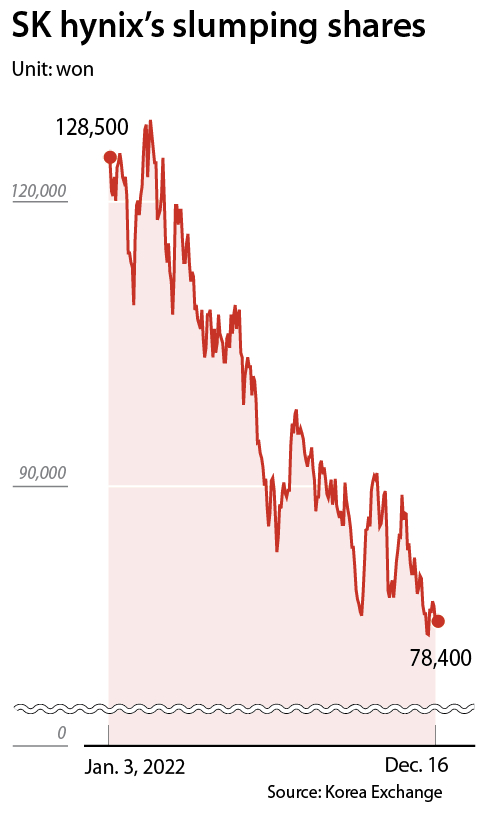SK hynix braces for Q4 loss, first in a decade
Published: 17 Dec. 2022, 06:00
![The logo of SK Hynix is seen at Korea Electronics Show in Seoul, South Korea, on Oct. 8, 2019. [AP]](https://koreajoongangdaily.joins.com/data/photo/2022/12/17/3b5f9681-adfe-4fd3-9ec0-986610de0761.jpg)
The logo of SK Hynix is seen at Korea Electronics Show in Seoul, South Korea, on Oct. 8, 2019. [AP]
SK hynix, the world’s second largest memory chipmaker, is projected to lose money in the fourth quarter for the first time in a decade as demand falters for memory chips.
The Korean chipmaker is forecast to report a 419.2 billion won ($320.1 million) operating loss for the October-December period, according to a consensus of 24 analysts tracked by FnGuide. Out of the 24 analysts, 17 predicted a loss in the fourth quarter.
If true, it would be the first loss since the third quarter of 2012 when prices of dynamic-random access memory (DRAM) plunged.
Unlike Samsung Electronics with its diversified range of semiconductors, SK hynix is heavily reliant on memory chips, making it vulnerable to cyclical downturns. Over 90 percent of its revenues come from memory products like DRAM and NAND flash chips.

“Clients for server chips are adjusting their inventory levels more drastically than expected,” said Park Yu-ak, an analyst at Kiwoom Securities.
“Demand for laptops and smartphones remains stagnant despite favorable seasonal conditions,” noted the analyst, who predicts an operating loss of 2.2 trillion won and net loss of 4.2 trillion won for the company in the fourth quarter.
A net loss for SK hynix in the quarter would include losses from an equity investment in Kioxia, formerly Toshiba Memory. SK hynix acquired a 15 percent stake in the Japanese chipmaker for 4 trillion won in 2017, but the value of those shares will likely decrease as Kioxia also suffers from lower chip demand.
The dramatic flip from chip shortage to glut has shaved 38.5 percent off the share price of SK hynix year to date as of Dec. 16, when the stock closed at 78,400 won.
This month alone, the chipmaker hit 52-week lows four times during trading days.
While its DRAM business continues to be profitable, losses will likely come from the NAND flash sector, which suffers steeper price declines than for DRAMs. The average selling prices for flash memory products will drop by 30 percent in the fourth quarter and DRAM prices will fall 25 percent, according to Wi Min-bok, an analyst at Daishin Securities.
The downturn in the NAND flash market was felt in the third quarter.
“Its revenue slipped by 29.8 percent quarter-on-quarter to $2.54 billion mainly due to the significant deterioration of the demand for PCs and smartphones,” said Taiwan-based market tracker TrendForce, referring to SK hynix's sales.
“Its subsidiary Solidigm was also affected by the slowdown in server procurements. Previously, servers had a fairly stable demand situation compared with other kinds of end products. However, server demand eventually buckled in the third quarter as result of enterprises cutting capital expenditure and undergoing a period of inventory correction,” it said.
Solidigm is a new corporate name for Intel’s NAND business unit, which was acquired by SK hynix last year. An SK hynix-owned U.S. business unit that includes Solidigm reported a 613.3 billion won net loss in the third quarter.
SK hynix is not alone in bleeding money.
Goldman Sachs analyst Toshiya Hari lowered his rating on Western Digital’s stock to Sell from Neutral on Thursday, pushing down the Nasdaq-listed stock by 10 percent that day. San Jose, California-based Western Digital is the fourth largest maker of NAND flash chips used for storing data.
The analyst said "multiple sources" told him that flash memory chip suppliers are offering their products below cash-cost prices to bring down inventories amid "a weak macroeconomic backdrop."
Shares of Micron and Nvidia also fell more than 4 percent on Thursday.
Samsung Electronics, the world’s largest memory chipmaker, is far from insulated from the price drops, although the company has a more abundant cash flow and flexibility in adjusting prices.
Choi Do-yeon, an analyst at Shinhan Investment & Securities, predicted that Samsung Electronics will report a 7.9 trillion won operating profit for the fourth quarter, down 27.3 percent on-year.
Of the profit, semiconductors will account for 2.8 trillion won, a 68 percent decline from the previous fourth quarter’s 8.84 trillion won.
Its stock had a rocky year, falling 24.3 percent compared to the beginning of the year.
BY PARK EUN-JEE [park.eunjee@joongang.co.kr]










with the Korea JoongAng Daily
To write comments, please log in to one of the accounts.
Standards Board Policy (0/250자)